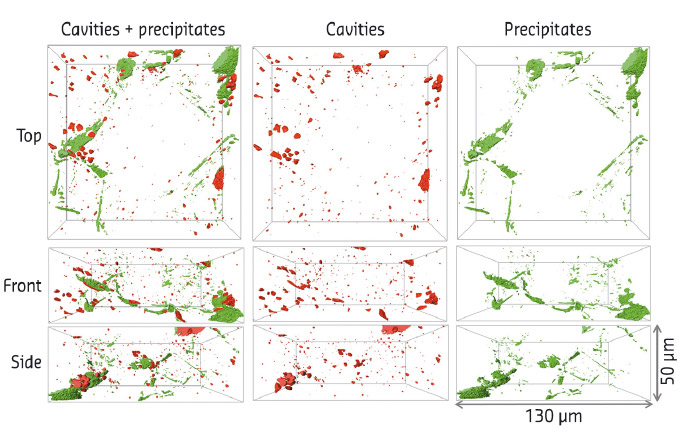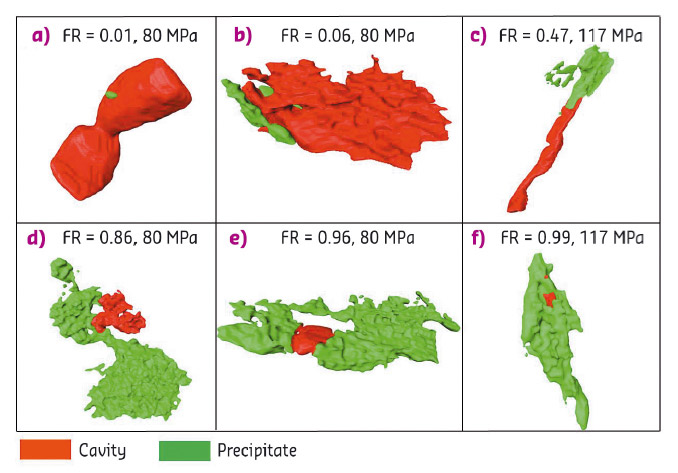- Home
- Users & Science
- Scientific Documentation
- ESRF Highlights
- ESRF Highlights 2016
- X-ray nanoprobe
- Direct view of self healing in Fe-Au alloys by X-ray nanotomography
Direct view of self healing in Fe-Au alloys by X-ray nanotomography
Self healing is a promising new approach to prolong the lifetime of steels exposed to high temperatures and stress for long time periods. Under these conditions, damage accumulates by creep cavities that continuously form at grain boundaries. X-ray nanotomography demonstrates that, for Fe-Au model alloys, efficient damage healing can be achieved by autonomous gold precipitation inside the cavities.
Steels are among the most widely-used construction materials due to their excellent and tuneable mechanical properties. However, when exposed to high temperatures for long time periods, steel components can exhibit premature creep fracture, which arises from the formation, growth and coalescence of creep cavities located at grain boundaries. In the self-healing steels we have developed, the enhanced creep lifetime originates from the precipitation of solid matter at the cavity surface, which prevents further growth of the creep damage. We recently demonstrated that efficient self healing of creep damage can indeed be achieved in a model system for such steels, the binary Fe-Au (1 at.% Au) alloy [1,2], as solute gold atoms show a strong tendency to form precipitates inside the creep cavities. To obtain a detailed view of the damage healing by site-specific gold precipitation inside the creep cavities (with a size of about 1 μm), the use of a 3D characterisation tool with a nanoscale resolution is essential.
We have performed synchrotron X-ray nano-imaging on creep-failed samples at beamline ID16A. The creep tests were carried out on homogenised samples at selected constant stress levels and at a temperature of 550°C. In the nano-imaging experiments, the X-ray beam energy of 33.6 keV made it possible to monitor the internal (nano-)structure of bar-shaped samples with a thickness of 200 μm in transmission. The high instrumental resolution with voxel sizes of 25 and 100 nm allowed us to successfully identify the open nanoscale cavities and gold precipitates within the alloy matrix. Both the open space of the cavities and the gold precipitates provided strong contrast in electron density.
 |
|
Fig. 40: Tomographic image of the microstructure in the Fe-Au alloy after creep failure (at 550°C and a stress of 80 MPa), identifying the presence of creep cavities (in red) and gold precipitates (in green). The stress is applied in the vertical direction. |
Figure 40 reveals the spatial distribution of the cavities and precipitates extracted from the creep-failed sample (tested at a constant stress of 80 MPa and a temperature of 550°C). As best observed in top view, the positions of the precipitates clearly mark the grain boundaries. With the grain-boundary positions identified, it was found that most of the cavities are indeed located on the grain boundaries. Figure 40 also reveals that the gold particles have distinctly different shapes: particles within the matrix are mainly spherical or equiaxed, particles on the inclined grain boundaries are more elongated or flattened, while particles located on the grain junctions have a relatively complicated shape.
 |
|
Fig. 41: Experimental creep cavities (in red) with varying degrees of filling with gold precipitates (in green). Indicated is the filling ratio (FR) and the stress level during the creep tests at a temperature of 550°C. |
Figure 41 shows several examples of partially filled creep cavities produced at different stress levels. The observed structures indicate that the filling process generally starts from one location and develops until the cavity is completely filled. When the precipitation is induced soon after nucleation of the cavity, the rapid filling stops further cavity growth, which results in a high filling ratio (FR). Note that unfilled cavities correspond to FR = 0, completely filled cavities to FR = 1 and partially filled cavities to 0 < FR < 1. Figure 41c shows a rod-like cavity that is nearly half filled by the precipitate from one side. In Figure 41f an open cavity has nearly been fully encapsulated. This demonstrates that the precipitate is filling the cavity rather than inducing the formation of the cavity.
We have analysed the filling ratio for more than 10,000 individual creep cavities per sample, which allowed us to understand the evolution of the creep cavities. After cavity nucleation at a size of about 50 nm, the cavities start to grow. When there is a free surface available, gold precipitation starts to fill the growing cavities.The cavity growth and the faster filling by precipitation continues in most cases until the cavity is completely filled. However, when two neighbouring partly-filled cavities connect, then the combined cavities grow faster and it is found that complete filling can no longer be achieved.
X-ray nanotomography has proven to be an excellent technique to characterise the self-healing mechanism for creep damage in iron-based alloys. The unique resolution makes it possible to monitor the broad variation in volume, shape and orientation of nanoscale creep cavities and the gold precipitation within these cavities. This insight is an essential step in the transition from model alloys to real multi-component creep steels with superior life time.
Principal publication and authors
Autonomous filling of creep cavities in Fe-Au alloys studied by synchrotron X-ray nano-tomography, H. Fang (a), C.D. Versteylen (a), S. Zhang (a), Y. Yang (b), P. Cloetens (b), D. Ngan-Tillard (a), E. Brück (a), S. van der Zwaag (a) and N.H. van Dijk (a), Acta Materialia 121, 352-364 (2016); doi: 10.1016/j.actamat.2016.09.023.
(a) Delft University of Technology, Delft (The Netherlands)
(b) ESRF
References
[1] S. Zhang et al., Adv. Eng. Mater. 17, 598-603 (2015).
[2] S. Zhang et al., Metall. Mater. Trans. A 46, 5656-5670 (2015).



